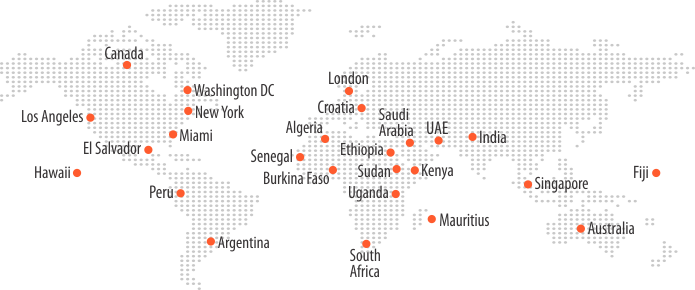The Worldwide Phenomenon of 5G Convergence

While 4G has a peak speed of 1gbps, 5G has a peak speed of 20gbps. With a much lower latency rate that promises to boost the performance of applications along with the overall digital experience, 5G seems like a potential start to a new world of telecommunication. While other generations focused on connectivity, 5G takes connectivity to another level by being more visual-focused and software driven. Additionally, 5G will also change VoIP services significantly, in a positive way.
VoIP business solutions use a much lower latency data transmission, which wasn’t possible in the initial stages of 5G. The current 5G that quite a lot of countries are starting to roll out has a low latency data transmission of 12 milliseconds and engineers are planning to lower it to 2 milliseconds. The new 5G also aims to improve the strength of VoIP solutions.
Evolution of 5G Till Now
The initially launched 5G technology depended heavily on pairing 4G technology or LTE infrastructure with non-standalone mode NSA before the standalone mode was developed further later and combined with 5G. Toward the end of April 2019, Global Mobile Suppliers Association had categorized over 224 network operators in 88 countries that were either testing out 5G or had been given a license to do field trials on 5G technology.
By the end of 2018, there were 192 5G operators in 81 countries globally. The first country to deploy 5G on a large scale was South Korea. When South Korea first launched its 5G network, all operators used Samsung, Ericsson, and Nokia base stations & equipment, except for LG, which used Huawei instead. Having shipped to 53,000 base stations at the time, out of the 86,000 base stations already installed across South Korea at the time, Samsung was the biggest provider of 5G in 2018.
The first extensive deployments were made in April 2019. In South Korea, SK Telecom had claimed 38,000 base stations, KT Corporation had taken 30,000, while LG U Plus had 18,000; of which 85% were in the six main cities. They were using a 3.5 GHz spectrum in the non-standalone mode (NSA) & tested speeds varied from 193 to 430 Mbit/s down. 260,000 subscribers signed up in the first month and by the end of 2019, they had 4.7 million subscribers or users. T-Mobile US was the first company globally to launch a more commercially available 5G NR Standalone network.
The Journey Ahead for 5G
The 5G transition has been rolled out in different stages across different countries. Most operators began with non-standalone, or NSA 5G & then transitioned to the standalone 5G. Only 18 countries had 5G standalone networks in the recent past. There also comes the question of what mix of 5G options will work best for different service providers and consumers, including businesses globally. There are three broad frequency bands that are being deployed with different characteristics: low-band spectrum 600Mhz-1GHz having speeds and range nearer to 4G & needs less cell towers; the mid-band (around 3300Mhz) offering 100-500Mbps speed is most in demand right now, and Millimetre-Wave 24-47GHz delivers the greatest speeds but needs strong cell towers every few 100 meters. The last band is in limited adoption, starting off as private networks for commercial use only.
T-Mobile, from the USA, raced to the lead position in the 5G transition with a range in smaller bands but competitors AT&T and Verizon. Jio’s plan of buying huge quantities of low-band range and Airtel’s idea to catch up with Jio in the 5G rollout by adopting not expensive non-standalone 5G technology suggests an intense race to win over customers. 5G promises new opportunities in the big bad technology world for the global economy by disrupting digitalization.
The 5G Network Spectrum
Low-band Spectrum for Better Coverage and Capacity
Sub-1 GHz spectrum has a strong propagation characteristic and is important to build better coverage in sparsely populated areas and provide stable indoor coverage within built-up areas. The spectrum requirement for 5G is higher than the amount of capacity that naturally exists below the 1 GHz spectrum. However, download speeds in areas that rely on low-band spectrum, typically rural areas, are directly affected by the spectrum capacity available, & making sure the availability of the 600 MHz spectrum bands will increase the rural broadband speeds by at least 30-50%.
Mid-band Spectrum for High Capacity 5G
Mid-band provides high capacity 5G. This will play a core role in delivering applications that influence the manufacturing processes, education system, building smart cities & communications. Mid-band 5G spectrum is estimated to deliver over $610 billion in global GDP by 2030, accounting directly for almost 65% of the entire socio-economic value created by 5G.
Enabling 5G Telecom
On the road ahead, lies the theoretical promise of 5G technology powered by better deployment of advanced technologies like AI, which in turn can stimulate domestic innovations in all fields. The 5G technology has undergone a powerful transformation to be what it is today but by no chance is the journey complete. New changes will mean new systems & rules for VoIP services & VoIP business solutions.
Related Posts
5G – The Final Frontier of The Connected World
The Role of Cloud-based IMS in the Growth of 5G Network






